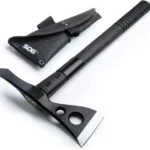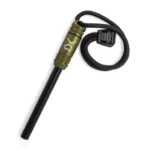You’re all set for the wilderness, but what if your gear isn’t up to snuff? The fact is that poorly maintained equipment can fail when you need it most. This guide unpacks essential tips to keep your survival tools ready and reliable.
Stay sharp – read on!
Table of Contents
Key Takeaways
- Wash and dry survival gear according to care labels, using a gentle detergent and avoiding high heat to protect materials.
- Store items in cool, dry places away from sunlight, use dehumidifiers in damp areas, and keep rechargeable devices on maintenance charge.
- Regularly check waterproof coatings on gear, clean with proper soap, test effectiveness, and reapply spray as needed.
- Inspect for wear before and after trips; replace frayed straps, busted buckles, or batteries; repair tears quickly with kits or seek professional help for complex damages.
- Fix minor issues right away to extend the life of your equipment; use patches for fabric tears and rust inhibitors for metal parts.
Importance of Maintaining Survival Gear
Taking care of your survival gear is like checking the smoke alarms in your house – it’s all about staying safe. Clean, well-maintained equipment works better and lasts longer. Think about a sleeping bag; it won’t keep you warm if it’s dirty or damp.
Washing and drying your gear means you’ll be cozy and dry when night falls.
Storing items correctly matters, too. Keep clothing, tents, and sleeping bags in a cool, dry place away from direct sunlight to avoid damage from mildew or fading. Use waterproofing sprays before heading out to ensure water repellency doesn’t fail when needed.
Batteries have expiration dates – check them regularly so they don’t let you down during emergencies. Take care of your gear now so it can take care of you later.
Essential Survival Gear Maintenance Tips
Keeping your survival gear in peak condition is more than a chore—it’s crucial to ensuring your safety and preparedness for the unexpected. I’ll guide you through some practical, no-nonsense strategies to preserve the integrity and functionality of your equipment, from cleaning practices that extend shelf life to proactive repairs that could make all the difference when it counts.
Washing and drying gear effectively
Washing your survival gear keeps it ready for your next adventure. Dirt and debris can wear down fabrics, so cleaning them right is important.
- Check the care label on your gear. It tells you how to clean each item safely.
- Shake off any loose dirt or debris before washing. This step keeps the washing machine from getting damaged.
- Use a front-loading washing machine if possible. Top loaders with agitators can be too rough on technical fabrics.
- Pick a gentle detergent made for outdoor gear, like Nikwax Tech Wash. It helps maintain water repellency and breathability.
- Run an extra rinse cycle to make sure all soap is out of your gear. Leftover detergent can mess with fabric performance.
- Air dry your items when possible. The high heat from dryers can ruin some materials.
- If you must use a dryer, choose a low or no – heat setting. This protects the durable water-repellent (DWR) coating.
- Reapply water-repellent spray after drying if needed. Items like pants and jackets often need their waterproofing refreshed.
- Store your gear in a cool, dry place away from direct sunlight once it’s completely dry.
Ensuring proper storage
Proper storage keeps survival gear ready for when you need it. Cool, dry places are best for keeping your items in good shape. Here are the steps to ensure proper storage:
- Choose a spot away from direct sunlight and moisture. This will protect gear from fading and mildew.
- Use a dehumidifier in storage areas prone to dampness. It helps prevent rust on metal parts and stops mold growth.
- Store scent-control clothing and hunting accessories in airtight containers. This keeps them ready for effective use during hunting trips.
- Keep first-aid kits sealed and check expiration dates regularly. Replace any items that are outdated or used up.
- Use gun safes for firearms to keep them secure and free of dust.
- Invest in high-quality gear bags for everything else. These bags protect your equipment from dirt and damage.
- Place rechargeable devices on a maintenance charge if not used frequently. This keeps batteries from losing their ability to hold charge.
Proper Storage of Tents and Sleeping Bags
Correctly storing your tent and sleeping bag between trips is essential for maintaining their performance and extending their lifespan. Improper storage can lead to issues like mold, mildew, broken zippers, and compressed insulation. Here are some key tips for storing these crucial pieces of gear:
Tent Storage
- Clean and dry: Before storing, always clean your tent of dirt and debris. Make sure it is completely dry to prevent mold and mildew growth.
- Loose storage: Store your tent loosely in a large, breathable bag or hang it up. Avoid keeping it tightly compressed in its stuff sack, as this can damage the fabric and coatings over time.
- Cool, dry place: Keep your tent in a cool, dry area away from direct sunlight, such as a closet or gear room. Avoid damp basements or hot attics.
- Separate from poles: Store tent poles separately from the tent body to avoid snagging or tearing the fabric.
Sleeping Bag Storage
- Clean and dry: Always make sure your sleeping bag is clean and completely dry before storing. Hang it up or lay it flat to air out.
- Loose or hung: Store your sleeping bag loosely in a large, breathable sack or hang it up by loops. Do not store it compressed in its stuff sack, as this will damage the insulation over time.
- Cool, dry place: Keep your sleeping bag in a cool, dry location away from moisture and direct sunlight, like a closet or dry gear room.
- Avoid compression: Never store your sleeping bag in a compression sack. Compression is only to be used for transport, not for long-term storage.
By following these storage guidelines, you can ensure that your tent and sleeping bag will be ready to provide reliable shelter and warmth on your next outdoor adventure. Proper care and storage will help you get the most value out of your gear investment.
Maintaining the waterproofing of gear
After securing your gear in storage, keep it dry and protected. Waterproofing your outdoor equipment is key to its longevity. Here’s how:
- Inspect gear often: Look for signs of wear or peeling on waterproof coatings.
- Clean regularly: Dirt and oils can break down the waterproof barrier.
- Use gentle laundry soap: Harsh chemicals can damage the coating.
- Avoid heat: Dry gear on low heat to protect the waterproof layer.
- Test waterproofing: Sprinkle water on the surface to check if it beads up.
- Apply a waterproof spray: Use Nikwax Fabric and Leather Proofing Spray after several washes to renew the coating.
- Follow instructions: Read product labels for proper application techniques.
- Allow to dry completely: Before storing, make sure your gear is fully dry.
Checking and replacing worn-out components
Survival gear needs regular checks to stay reliable. Worn-out parts can fail you when least expected, so replace them early.
- Inspect all your gear thoroughly before and after trips. Look for signs of wear, like fraying straps or loose seams.
- Focus on high-use areas such as zippers, buckles, and fastenings. These parts can break easily with heavy use.
- Test the functionality of tools and devices to make sure they work properly. If a tool is rusty or stiff, it might need oiling or replacing.
- For electronic devices, take out batteries if you won’t use them for a while. This avoids corrosion and keeps devices safe.
- Consider the age of your pads and other protective items. Materials degrade over time, reducing their effectiveness.
- Seek professional repair services for any complicated damages you can’t fix yourself. They have the right tools and expertise.
- Keep a small repair kit handy with essentials like duct tape, sewing materials, and replacement parts for quick fixes on the go.
Repairing minor damages promptly
Taking care of small repairs quickly can save you from big problems later. Your survival gear will last much longer if you fix tears, holes, and other damage soon after they happen. Here’s how to keep your gear in top condition:
- Inspect your gear after each use. Look for any signs of wear or damage. This includes checking for loose threads, rips, or punctures.
- Use a repair kit. Keep one handy that’s suited for your specific gear. It should include items like patches, adhesives, and a sewing kit.
- Follow the right method for fabric tears. If you find a rip in your tent or backpack, use a fabric patch and seam sealer to mend it.
- Take care of leather items. Apply a leather conditioner for hiking boots with minor scuffs or cuts to prevent further damage.
- Fix broken buckles and straps fast. Many replacement parts are universal and can be easily swapped out without special tools.
- Address rust on metal components immediately. Remove rust with sandpaper and protect the area with a rust inhibitor.
Patching a Hole in Your Tent
Even with proper care, tents can sometimes develop holes or tears. Whether from a sharp rock, a broken pole, or a campfire spark, a hole doesn’t have to mean the end of your tent’s usable life. Most small to medium holes can be patched fairly easily with the right supplies and techniques.
Here’s a step-by-step guide to patching a tent hole:
- Clean the area around the hole. Use an alcohol wipe or damp cloth to gently remove any dirt or debris. Let the fabric dry completely.
- Cut a patch from tent repair tape or a patch kit, rounding the corners. The patch should extend about a half-inch beyond the edges of the hole on all sides.
- If the hole is large, you may need to use a piece of mesh or tent fabric as a backing. Place this inside the tent behind the hole.
- Apply the adhesive patch to the outside of the tent, smoothing it down firmly. If using a two-sided patch kit, apply the second patch to the inside of the tent.
- Seal the edges of the patch with seam sealant. This will help prevent the patch from peeling. Let the sealant dry completely according to product instructions.
- As an extra measure for larger repairs, you can sew around the edges of the patch before sealing. This helps reinforce the repair and prevent further tearing.
With this patching method, your tent should be ready for many more adventures. Remember, it’s always a good idea to carry a tent repair kit with you on camping trips for quick fixes in the field. For major damage or if you’re not confident in your repair skills, consider having your tent professionally repaired to ensure its integrity and waterproofing.
Fixing a Rip in Your Sleeping Bag
A torn sleeping bag can quickly lose its insulating properties, leaving you cold and uncomfortable on camping trips. While major damage may require professional repair, most small rips and tears can be fixed at home with a few simple tools and techniques.
Here’s how to patch a rip in your sleeping bag:
- Clean the area around the rip. Use a soft brush or damp cloth to remove any dirt or debris. Make sure the fabric is completely dry before proceeding.
- If the rip is on a seam, you’ll need to restitch it first. Use a sewing needle and thread that matches the color of your sleeping bag. Sew a simple overcast stitch along the seam, making sure to keep the stitches close together.
- For rips on the main body of the bag, you can use a self-adhesive nylon patch or repair tape. Cut the patch into a circular or oval shape, making sure it’s large enough to cover the rip with at least a half-inch of overlap on all sides.
- Apply the patch to the outside of the sleeping bag, centering it over the rip. Press down firmly, smoothing out any wrinkles or air bubbles. If using a two-sided patch, apply the second piece to the inside of the bag.
- For added durability, you can sew around the edges of the patch. Use a sewing needle and thread to create a simple whipstitch or overcast stitch, making sure not to sew the front and back of the bag together.
- If your sleeping bag is down-filled, you may need to redistribute the down after patching. Gently shake and massage the bag to encourage the down to move back into place.
By following these steps, you can extend the life of your sleeping bag and ensure it continues to provide reliable warmth and comfort on your camping adventures. Remember to always handle your sleeping bag gently and store it properly to minimize the risk of rips and tears.
Conclusion
Remember, taking care of your survival gear means it will take care of you. Keep everything clean, dry, and well-stored. Stay on top of repairs and replace parts when needed. Your equipment’s life depends on this attention to detail.
So go ahead – show your gear some love and stay ready for whatever comes your way!
FAQ
Why is maintaining survival gear important?
Maintaining your survival gear is crucial for ensuring your safety and preparedness in unexpected situations. Just like checking smoke alarms in your house, taking care of your equipment ensures it functions properly when you need it most. Clean, well-maintained gear works better and lasts longer, making it a vital practice for anyone relying on such equipment in outdoor or survival scenarios.
How should I wash and dry my survival gear?
To wash and dry your survival gear effectively, check the care label for specific instructions. Remove any loose dirt or debris before washing. If possible, use a front-loading washing machine to avoid damage from agitators found in top loaders. Opt for a gentle detergent designed for outdoor gear to maintain water repellency and breathability. Run an extra rinse cycle to remove all soap, and air dry your items when possible to protect the materials. Select a low or no-heat setting to safeguard the durable water-repellent (DWR) coating if using a dryer.
What are the best practices for storing survival gear?
Proper survival gear storage involves keeping items in a cool, dry place away from direct sunlight and moisture to prevent damage from mildew or fading. Use a dehumidifier in damp areas to prevent rust on metal parts and mold growth. Store scent-control clothing and hunting accessories in airtight containers to maintain their effectiveness. Regularly check and replace any outdated or used items in your first-aid kits, and use gun safes for firearms to keep them secure and free of dust.
How can I maintain the waterproofing of my gear?
To maintain your gear’s waterproofing, regularly inspect for signs of wear or peeling on waterproof coatings. Clean your gear with a gentle laundry soap to avoid damaging the waterproof barrier and avoid exposing it to high heat. Test the waterproofing by sprinkling water on the surface to see if it beads up. If necessary, reapply a waterproof spray, such as Nikwax Fabric and Leather Proofing Spray, after several washes to renew the coating.
What should I do about the worn-out components of my gear?
Regularly inspect all your gear for signs of wear, such as fraying straps or loose seams, especially before and after trips. Pay close attention to high-use areas like zippers, buckles, and fastenings. Test the functionality of tools and devices to ensure they work properly, and replace batteries or worn-out parts as needed. For any complex damages, seek professional repair services to ensure your gear remains reliable.
How do I repair minor damages to my gear?
Addressing minor damages promptly can significantly extend the life of your survival gear. Inspect your gear after each use for any signs of wear or damage. Use a repair kit tailored to your specific gear, including patches, adhesives, and a sewing kit, for fabric tears. Apply leather conditioner to hiking boots for minor scuffs or cuts, and replace broken buckles and straps as soon as possible. For metal components, remove rust with sandpaper and apply a rust inhibitor to protect the area.


















Leave a Reply